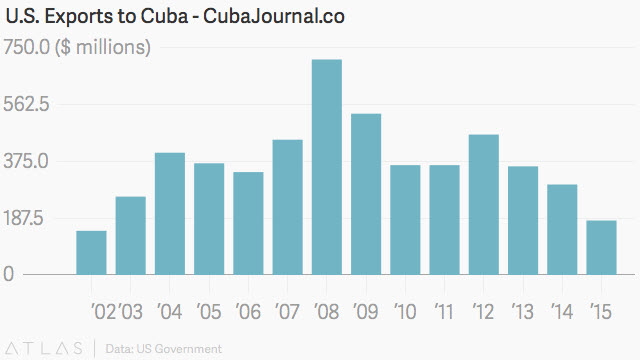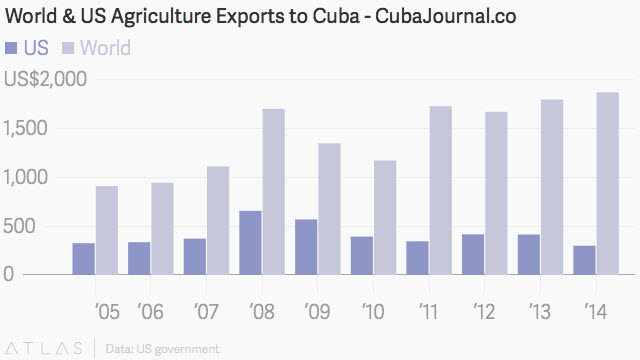By Simons Chase, guest columnist
The Trade Sanctions Reform and Export Enhancement Act (TSRA) of 2000 launched a boom in exports from the US to Cuba that had previously been restricted since the early 1960s. US exports to Cuba rose from about $7 million in 2001 to a high of $712 million in 2008, making the US Cuba’s largest supplier of agricultural products for many of those years.
Since 2008, conditions have changed and US suppliers now occupy a fraction of the Cuban market share they once commanded. US exports to Cuba declined considerably from 2009 through 2011, rose again in 2012, and have fallen every year since then. US exports to Cuba dropped a whopping 40% from 2014 to 2015, the lowest level since 2002. In the first quarter of 2016, US exports to Cuba continued to fall, amounting to just $53 million compared to $74 million in the first quarter of 2015, a 28% decline.
In total, Cuba purchased more than $5.2 billion in US products from 2001 to 2015, largely agricultural products. Cuba depends on imports for more than half its annual consumption, making it an ideal buyer for US producers.
The recent decline in US market share can be explained by a decrease in bulk commodity exports in light of favorable credit terms offered by key competitors.
Under TSRA, US exporters cannot extend terms of credit, and exports to Cuba must be purchased using cash or through third-party guarantees from foreign banks. Furthermore, there is a single Cuban government import entity, Alimport. Additionally, the US Foreign Agricultural Service and other US government agencies are barred from providing market development assistance – which is typically a key component of US efforts to build trade capacity and boost export opportunities in other countries.
Full liberalization of trade between the US and Cuba would allow US agricultural exports to compete on a more level playing field by allowing use of credit facilities, export and technical assistance, and market development programs. Cuba’s $5.9 billion in total annual imports is likely to grow significantly in the near future as tourism growth drives demand for more goods including agricultural products. But, unless the rules change, those masses of new US tourists won’t be eating US rice, corn and wheat in Havana.
For the very latest updates on export opportunities for the US agricultural industry in Cuba, join me at Datamyne’s Preparing for Trade with Cuba Conference in Miami, October 13.
About Simons Chase  Founder and editor in chief of Cuba Journal (CubaJournal.co) Simons Chase has over 20 years of media, technology and principal investing experience. He has held leadership positions in a range of tech startups including, in the last five years, CEO of digital marketers Instra Corporation (New Zealand).
Founder and editor in chief of Cuba Journal (CubaJournal.co) Simons Chase has over 20 years of media, technology and principal investing experience. He has held leadership positions in a range of tech startups including, in the last five years, CEO of digital marketers Instra Corporation (New Zealand).
Related:
- Simons Chase will be a speaker at Datamyne’s Preparing for Trade with Cuba Conference, this year in Miami on October 13. The Conference will feature case studies from entrepreneurs and investors doing business in re-opening Cuban markets. Learn more >





